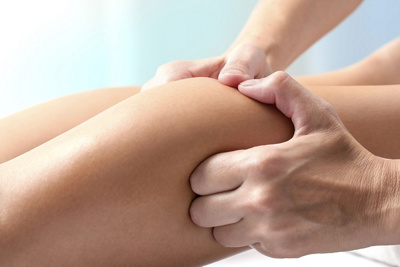In cases of chronic pain, the pain the patient feels may be referred pain and the source of the pain lies elsewhere. Osteopaths locate the precise cause of various types of discomfort through specific manual manipulations and awaken the body’s own self-healing powers.

Osteopathy is used for disorders and pain in the musculoskeletal system, the internal organs and the craniosacral system. This is a holistic treatment method. Respectively, osteopathy focuses on the health of the whole body, not just injured or affected parts and or single body structures, such as the bones, joints or muscles. The focus lies on the interaction of the different structures and systems in the body.
If movement of the joints or tissues is reduced, the body initially reacts to these changes by adjusting and compensating. If a disorder lasts too long or more imbalances in the development of free movement occur, the body reaches the limits of its ability to adapt. The result is dysfunctions, which may manifest as tension, restricted movement and pain. A central element of osteopathy is locating the cause of these dysfunctions. The site of the pain or impairment is not always the place where it originates. Osteopathy is a form of medicine in which therapeutic intervention stimulates self-healing.
Osteopaths exclusively use "hands-on", i.e. manual methods. This means that they do not work with instruments, but instead administer the treatment using specialist hand techniques. Osteopathic treatment is always performed with the involvement of a specialist in the respective discipline.
Osteopathy may be used for:
- Chronic dysfunction of the musculoskeletal system
- Acute blockages in the spine
- Stiff neck
- Acute and chronic pain
- Digestive discomfort
- Discomfort after accidents/whiplash
- Post-operative pain
- Headaches and dizziness
Osteopathy may also be used for:
Osteopathy for sportspeople
Osteopathy for sportspeople
Sports osteopathy helps body systems that are exposed to particularly high physical demands to work together better. This enables you to achieve peak performance without excessive strain on the body.
Sports osteopaths identify imbalances, functional, structural and systemic disorders, and treat them. They also improve and strengthen the body’s own regenerative powers. The treatment lays the groundwork for potentially higher levels of performance.
Sports osteopathy may be used for:
- Pain due to excessive strain
- Pain around the musculoskeletal system
- Rehabilitation after accidents and surgery
- Preparation for a competition
- Regeneration after peak loads
Osteopathy for infants and small children
Osteopathy for infants and small children
Infants may suffer from various types of discomfort. Frequent symptoms include wry neck, colic, head flattening, excessive crying or digestive discomfort. Osteopaths mobilise the self-healing powers of infants and small children with specific hands-on techniques. The gentleness with which osteopathic treatment is performed makes it the ideal method for babies and small children. Osteopathic treatment is pain-free for children and has no side effects. Additionally, specially trained osteopaths always provide the parents with information on their child’s early physical development.
Osteopathy may be used for babies and small children in cases of:
- Excessive crying
- Cranial asymmetry
- Wry neck
- Motor asymmetry
- Impaired mobility
- Breastfeeding problems
- Bloating, constipation, colic
- Oral cavity development disorders and/or preorthodontic treatment
- Eye disorders such as heterophoria (latent squint)
- Breathing problems, asthma
- Recurrent middle ear infections
- Sleep disorders, disturbed sleep
Osteopathy during pregnancy and after giving birth
Osteopathy during pregnancy and after giving birth
During pregnancy, a woman’s body changes constantly. At first, these changes are frequently associated with symptoms such as headaches, nausea, vomiting and dizziness. Later on, the focus is often on discomfort associated with the musculoskeletal system, particularly the lumbar spine and pelvis. Osteopathic treatment can relieve this discomfort and provide ideal preparation for a natural birth.
During pregnancy, osteopathy may be used for:
- Restricted mobility of the musculoskeletal system
- Acute blockages in the spine
- Discomfort around the pelvis
- Frequent reflux, heartburn or nausea
- Digestive discomfort
- Headaches and dizziness
- Sensitivity disorders in the hands or wrists
- Non-optimal fetal position for birth
After giving birth, osteopathy may be used for:
- Pain in the musculoskeletal system
- Posture-related neck pain
- Pain around a caesarean scar
- Nipple infections
- Constipation
Osteopathy for pelvic floor problems
Osteopathy for pelvic floor problems
A balanced and functioning pelvic floor is important not only for the stability of the back but also for pelvic organ function. Imbalances in the pelvic floor can lead to pain and incontinence.
Osteopathic treatment of the pelvic floor involves not only particular manual techniques but also training therapy. The pelvic floor is made up of muscles that can be actively trained. It is important to do these pelvic floor exercises every day.
Osteopathy may be used for pelvic floor issues such as:
- Incontinence
- Pain around the pelvic floor
- Back pain associated with loss of pelvic floor function
- Pain during sexual intercourse
- Discomfort caused by scars
- Cycle-dependent back pain/headaches
- Pain around the coccyx
- Recurrent urinary tract infections
Why choose Hirslanden
Osteopathy is a key specialisation at Hirslanden, the largest private hospital group in Switzerland. Our osteopathy specialists are renowned for their expertise and many years of experience.
You can expect comfortable rooms and a modern infrastructure as well as the highest standards in medicine and care.
We will help you throughout your entire stay, organising additional services such as translators and interpreters, transport, and overnight hotel stays for you and your relatives, and addressing all your administrative questions.
A personal contact from the Hirslanden International team will take care of your needs from the time that you first contact us to arrange an appointment through to the end of your treatment.
Contact us – we are happy to help you!

